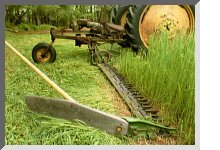What is a "live" PTO?
|
Hi Meli,
Okay Brandon,
Now, can you explain a
Live and Non Live PTO?
Okay... Some live PTOs may be set up different, but I will describe my JD 80, which
has a live PTO. The controls will also be different from tractor to tractor.
There is a shaft that runs from the crankshaft to the rear of the tractor
(Of course it turns all the time) Between this shaft and the PTO is a clutch
that can be engaged and disengaged to start and stop the PTO when needed,
which is controlled by a lever by the hand clutch. It is totally independent
from the main tractor clutch. Some JDs were able to completely disengage the
live PTO from the engine if you weren't going to use it. My 80 can't do
that. The main advantage of Live PTO is that you can stop and start moving the
tractor, without stopping the PTO. You probably noticed that when you stop
your B, the sickle mower stops. Live PTOs are great for balers when they
start to overload! Stop the tractor, let the baler run the hay through, then
start again.
And why shouldn't you brushhog near trees with a non live PTO? Okay, tell me about THIS too! We mow with the No.5 sicklebar and we have several trees we have to go around. There is never a problem. Is there something WORSE about brushhogs?? If you haven't guessed it, we don't have one of THOSE, either. Well, the brushhog has blades like a lawn mower, and most brushhogs are about 5 feet wide. Those long blades take quite a while to stop after they get going (momentum)! With a non live PTO, the PTO is driven from the transmission gears. While using a brushhog, if you try to stop by pulling back on the clutch (or stepping on the pedal), you will stop and disengage the engine from the transmission, BUT!! the brushhog will continue driving the tractor forward (the brakes won't do much to help)!!! And if you have an obstacle in the way, that might be a problem! The only way to stop moving is to disengage the PTO, or slip the tractor out of gear. With live PTOs, this is not a problem, since it is not driven from the transmission. Oh, I see. Since the PTO is still connected to the transmission and ultimately to the wheels, the brushhog continues to turn the transmission. I suppose if you had the presence of mind to disengage the PTO lever at the same instant that you disengage the clutch, you WOULD be able to stop. But WHO can think that fast!! Here is a drawing of a live PTO out of a model 50, if you'd like to show it to everybody. It is set up totally different from my 80! |
| Okay, Here it is....  |
|
Yes, I can see that the powertrain to the PTO is completely independent of the powertrain from the engine to the wheels. This was one of the big selling points of the "First Numbered Series" that replaced the "Letter Series" in 1952. THANKS Brandon!! You're welcome, Meli.
|
Go back to the page you just came from......
"Poetry in Motion"
Johnny Tillotson, 1960
 That's a good idea, TOO! The trouble is, the newest tractor we have ever had on this farm
is a 1950 Model B. We have never used a live PTO and don't know exactly how it is set up. I DO know that there is another
train of gears and another clutch, but I don't even know WHERE the clutch is located and
what it LOOKS like!! If you are familiar with the live PTO,
would you tell us a little bit about it?
That's a good idea, TOO! The trouble is, the newest tractor we have ever had on this farm
is a 1950 Model B. We have never used a live PTO and don't know exactly how it is set up. I DO know that there is another
train of gears and another clutch, but I don't even know WHERE the clutch is located and
what it LOOKS like!! If you are familiar with the live PTO,
would you tell us a little bit about it?
 Yes, many times with the mower, when you get into a heavy cut, you wish you could "ride the clutch" on the tractor, to slow down and let the mower catch up, but unfortunately this slows down the blades on the MOWER, too!!
Yes, many times with the mower, when you get into a heavy cut, you wish you could "ride the clutch" on the tractor, to slow down and let the mower catch up, but unfortunately this slows down the blades on the MOWER, too!!
